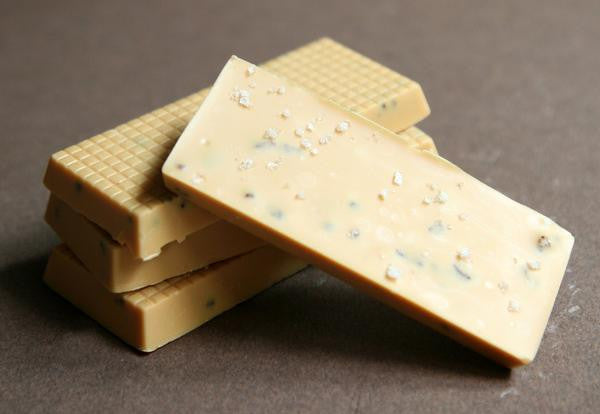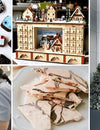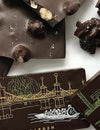
I admit it: I'm a fan boy of Elaine Hsieh Chocolatier. A huge fan. I have a double subscription to their Chocolate Of The Month Club. I buy their chocolates anytime I get the chance, like when I'm at the Farmer's Market or Formaggio. I've attended their class. I bring their chocolates as gifts to people in Japan knowing that there are no finer chocolates, anywhere. I've run side by side comparisons with other high-end chocolates and written about it on Yelp.
Fully aware that I'm a like a 13 year old at a Justin Bieber concert when it comes to their creations, Elaine and Catherine (I'll refer to them as "E&C") asked me to write a guest entry for their blog; I naturally accepted their offer. But what would I write about? Every time I eat one of their bon bons (or any of their other concoctions), I gush over how extremely good it tastes. The textures are perfect. The flavors subtle when necessary, but bold and singular when it's called for. So when dwelling on potential blog topics, I couldn't get out of the rut in that I'd write about my three favorite recipes, even though that seemed so mundane. Besides, how would I possibly pick only three? I pretty much love every one of them.
Allow me to digress. Whenever I eat some sort of new dish that pushes the envelope on flavor, technique, or execution, I wonder about the process that the chef used to conceptualize and refine it from conception to mouth. And when I bite into one of E&C's chocolates, I wonder "how did they ever think of this?" I'll change the topic (again) to football so that I can I make a gratuitous sports metaphor. Bill Belichick -- maybe you've heard of him, he's head coach of the New England Patriots -- is often called the "evil genius" because of his incredible knowledge of football. When I hear him analyze a game or a play, I wonder "How does he understand all this?" Along the same vein I often think (very respectfully) that Elaine and Catherine are the evil geniuses of the chocolate world -- the Bill Belichicks as it were -- who understand the subtleties of working with chocolate, diverse ingredients, the palate -- the entire process -- and can create incredible new tastes. And there was my topic: I would write about the creative process that the geniuses of chocolate go through when they develop a new flavor.
In January's Chocolate of the Month club box (yeah, I had two boxes), my favorite piece was "Hot Chocolate", so I decided to find out how Elaine and Catherine conceptualized and developed this unbelievable morsel of dark chocolate which oh-so-cleverly integrates marshmallow flavor. I approached Elaine with this topic and she graciously spent time talking me through the whole creative process.

When Elaine and Catherine first became chocolatiers, they tested some of their concepts on their friends and family to see if they could make a business out of it. "Hot Chocolate" is one of the products from that era. Back then they typically worked in small batches so they had more time to refine this particular idea than they typically have with their newer products. Elaine recalled that it was a "snowy kind of winter that year" and they had envisioned doing something which reminded them of hot chocolate. She told me "It's a memory of [a hot chocolate] they had before, but not necessarily an actual [hot chocolate] they had before. I know that doesn't make sense so let me try to clarify. Hot Chocolate is a memory of hot chocolate, but it is also (paraphrasing Elaine) "if I were to make an ideal hot chocolate it would be like this."
For the initial iteration, they wanted a chocolaty hot chocolate base. Even though they tend to do a lot of varietal work, they chose the Michel Cluizel 67% and cream for the ganache with a little Creme de Cacao for the extra depth -- "To pump it up a bit."
Elaine's daughter insisted that Hot Chocolate had to have marshmallow. After all, what is hot chocolate without marshmallow? This was a bit of a test because E&C had never made marshmallow and there are all sorts of different ways to make them. They tried six or seven different recipes (some were too soft and some were too firm) before they settled on a gelatin-based recipe. "It held up, but was not too firm".
For the marshmallow to chocolate ratio, they originally thought they wouldn't use a lot of marshmallow. So they started with a 1/4" layer, reduced it to a 1/8" layer, but then went back the other direction to a 50:50 proportion. Even then they thought the marshmallow was too muffled, so ultimately they ended up using more marshmallow than chocolate.
After the marshmallow to chocolate ratio was settled, further testing led them to believe that they needed more vanilla than is called for by most recipes. Elaine educated me about how most vanilla extracts are alcohol-based and therefore require that it be added at the end of the process. But if it's a high-heat recipe, like marshmallow, the alcohol evaporates so you lose the vanilla flavor. E&C use a French vanilla which is processed in a sugar syrup so it doesn't evaporate at the same rate. That same producer also makes a vanilla powder based on dried vanilla bean. "Hot Chocolate" went through several more iterations trying to iron out the exact recipe with the right vanilla (liquid vs powder, when to add it, how much, etc.)
Not to mention the complications presented by a two-layer bon-bon. In all, E&C went through 10 iterations to refine the recipe. Elaine told me that generally, a single-layer recipe takes 5 or 6 iterations before they know whether they have a keeper or a loser (a third option is to set a new idea aside for another try sometime later). With so many iterations, there's also the understandable recipe fatigue of making minor refinements and not really knowing whether they're going in the right or wrong direction. During development, they don't save the old batches for comparison so the refinements are all done from memory. They pretty much know the first batch won't work, but use that run to set a baseline for further refinements towards their original vision. Hopefully each refinement makes progressively smaller changes.
Once they had a satisfactory Hot Chocolate recipe, they needed to move from concept to production, a process which Elaine said was relatively easy. During development they work in small quantities and their experience has taught them the limits of how far they can increase the size of their batches. If it's a milk varietal, they can generally keep expanding the recipe. If it's something more complex, they can typically expand to 3 times the size without much trouble. If they need more, then they do double batches. Their cutting equipment limits them to 15x15" batches.

E&C's ideas are influenced by different factors. For instance, the caramelized white chocolate bars that I oh-so-love were inspired by David Leibowitz. E&C both love to cook savory foods, and the salt in these bars is the non-sweet side of their culinary genius speaking. In her Asian cooking background, Elaine remembers her mom always putting a little pinch of sugar into her recipes. The salt in this recipe is the antithesis in that they're throwing a bit of savory (the salt) into their bars.



